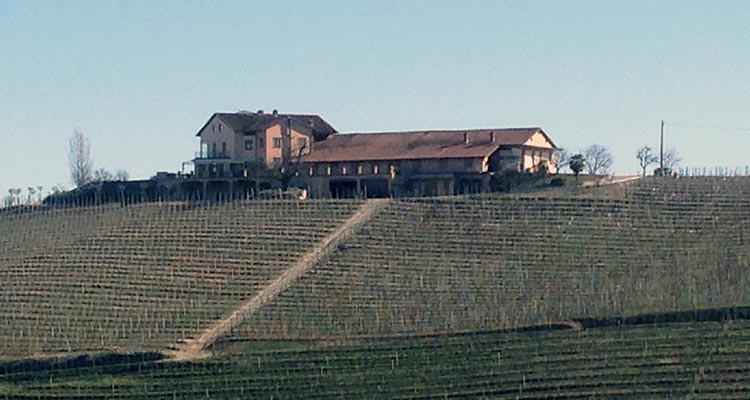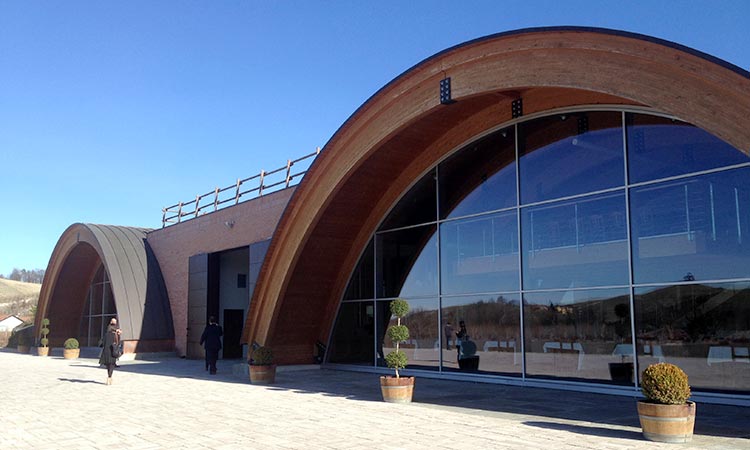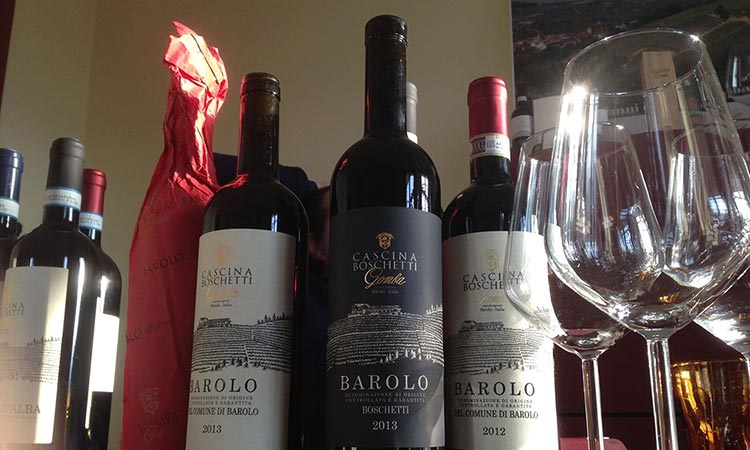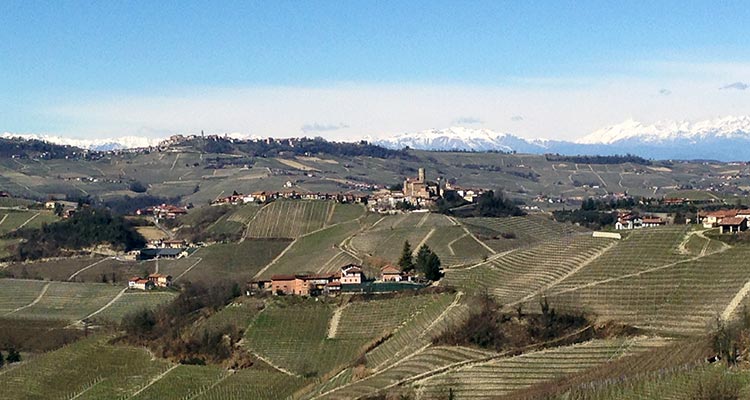Imagine waking up in a place surrounded by some of the most famous Italian vineyards – the wineries of Barolo. Picture opening the window and seeing the sun’s rays stretching along the hills, brightening a carpet of grapevines. To a wine lover, this may be the absolute best way to greet the day. A few weeks ago, I was lucky enough to live this dream. A friend of mine, Giampiero Sappa, invited us to visit Cascina Boschetti Gomba, where he is in charge of exports. But I wasn’t just looking for a great view; I was looking for great Barolo – that doesn’t cost the earth. On this trip, I found several of them, produced by Boschetti Gomba and Sordo.
As every true wine lover knows (or should know) the official recognition of the DOC Barolo came in 1966, and the DOCG in 1980; the grape variety is 100% nebbiolo. The production zone covers the entire township of three villages – Barolo, Serralunga d’Alba and Castiglione Falletto – and part of the territory of eight other small townships.

To reach the winery Cascina Boschetti Gomba, we cross the most iconic areas of Barolo township, passing renowned names like the Cannubi vineyards, Poderi Einaudi and Michele Chiarlo. Our destination – which is not far from these mythical places – is set exactly on top of a hill in front of the village of Barolo. The winery itself lies in the midst of 11 hectares (~27 acres) of vineyards planted with nebbiolo: a unique situation in this denomination.
Owner Sergio Gomba is a reserved man who is passionate about viticulture. Though I don’t meet him, Sappa tells me his story: “He was born 73 years ago in a family of grape-growers in the nearby Alba area, and his first purchase was here in Barolo, where 25 years ago he bought his first two acres of vineyards. In the following years, he acquired many other vineyards in Boschetti as well as in different villages of the region.”
If this were France, Boschetti would be called a “cru,” but here in Piedmont the people call it a “sorì”, or Menzione Geografica Aggiuntiva (MGA, or “Individual Vineyard Name”); over 100 MGAs were officially recognized in 2010. [For more information about this, the best book and map on Barolo to get is Barolo MGA: The Barolo Great Vineyards Encyclopedia, edited by Italian publisher and wine journalist Alessandro Masnaghetti.)
Not every MGA is considered to be of great value. In the most renowned (like Bussia, Cannubi, Brunate, Rocche and Monfalletto, to name just a few), the wines cost an arm and a leg. But in many others – either less well-known or deemed less important by wine experts – including Boschetti, it’s easy to find excellent Barolo that is also more approachable. Being very close to the famous Cannubi, Boschetti has many interesting features: the slopes of the hill are sweet, the sun exposure is ideal and the soil is variable with some sand in the yellow marl. Furthermore, in recent years Boschetti has benefited from climate change, which is why Barolo of Boschetti Gomba has more freshness, drinkability, and fragrant flavors. The top wine of their production – 2013 Cascina Boschetti Gomba Barolo DOCG – is elegant, with balsamic scents and floral flavors of violet, followed by spicy notes, black pepper, bitter cocoa and coffee powder. A wine that makes you hungry.
The same thing can be said about Barolo produced in eight different MGAs (Monvigliero, Ravera, Perno, Gabutti, Parussi, Rocche di Castiglione, Villero and Monprivato) from just one producer: Sordo. Founded at the beginning of the 1900s with just 3 hectares (~7.5 acres), today this winery presides over 53 (~130 acres). “We are in the lower Piedmont (Cuneo province), explains Ernesto Minasso, Sordo’s winemaker, “and what characterizes these areas is the soil: it’s here that nebbiolo has its choicest land.” Minasso produces wines in the traditional style, and loves to age his Barolo in big barrels – with none of those sometimes-fashionable aromas like vanilla that are typical of new barriques.

In the Barolo appellation, two soil types – Tortonian and Helvetian (or Serravallian), both of which were formed millions of years ago – produces different styles of nebbiolo. The former, found in the townships La Morra and Barolo to the west, is less compact and more fertile, resulting in wines that are elegant and (relatively) approachable. Helvetian, the soil of Serralunga d’Alba, Monforte and Castiglione Falletto, is full of dense, compact marl, producing Barolo that’s full of body and alcohol, suitable for long aging.
Keeping this in mind, everybody can find his or her favorite Barolo by carefully choosing which sorì (MGA) the grapes come from, rather than looking for the most renowned (and expensive) names.
Tasting Notes
2013 Sordo Barolo Monvigliero
The grapes come from a sorì (cru) which is rather special, with a soil rich in silicon and plaster. The wine has quite subtle scents of menthol, followed by a hint of cocoa. In the mouth, the tannins are slightly dusty but the taste is of red fruits.
WHO: Sordo
WHERE: Verduno, Piedmont, Italy
MGA: Monvigliero
WHAT: Nebbiolo
HOW MUCH: $30 (Media Sample)
2013 Sordo Barolo Ravera
The nebbiolo grapes of this Barolo are from a vineyard at 420-450 meters (1,370-1,470 feet) of altitude, with a greater sun exposure. Accordingly the wine is richer, the color is an intense dark red, the flavor more intense and fruity. The alcohol is well balanced, with good acidity, although the final taste is a bit bitterish.
WHO: Sordo
WHERE: Novello, Piedmont, Italy
MGA: Ravera
WHAT: Nebbiolo
HOW MUCH: $44 (Media Sample)
2013 Sordo Barolo Perno
A Barolo with fruity flavors of cherries and plums, well structured, with a nice end-palate and strong tannins.
WHO: Sordo
WHERE: Monforte d’Alba, Piedmont, Italy
MGA: Perno
WHAT: Nebbiolo
HOW MUCH: $40 (Media Sample)
2013 Sordo Barolo Gabutti
A wine with nice balsamic flavors, and interesting notes of exotic woods. Fruity in taste, it’s warm, clean in its balanced finish, and very drinkable.
WHO: Sordo
WHERE: Serralunga d’Alba, Piedmont, Italy
MGA: Gabutti
WHAT: Nebbiolo
HOW MUCH: $40 (Media Sample)
2013 Sordo Barolo Parussi
The flavors of this wine are more floral than fruity, but the taste also features juniper berries. Good acidity.
WHO: Sordo
WHERE: Castiglione Falletto, Piedmont, Italy
MGA: Parussi
WHAT: Nebbiolo
HOW MUCH: $40 (Media Sample)
2013 Sordo Barolo Rocche di Castiglione
This Barolo has dark scents of menthol, tobacco and iodine, a good acidity, red fruits in the mouth and a persistent finish.
WHO: Sordo
WHERE: Castiglione Falletto, Piedmont, Italy
MGA: Rocche di Castiglione
WHAT: Nebbiolo
HOW MUCH: $45 (Media Sample)
2013 Sordo Barolo Villero
From a quite small vineyard (just 1.24 acres) of old vines, this Barolo is austere, with notes of dark tobacco and leather on the nose. In the mouth it is fresh, with a rich bouquet of red and blue soft fruits. It’s a new wine for Sordo, with only 3,600 bottles produced.
WHO: Sordo
WHERE: Castiglione Falletto, Piedmont, Italy
MGA: Villero
WHAT: Nebbiolo
HOW MUCH: N/A (Media Sample)
2013 Sordo Barolo Monprivato
With this second new cru in production, Sordo is now the winery which makes wines from the most MGAs in the Barolo area. The wine has a rich bouquet of flavors (red fruits, licorice, sweet spice) a nice balance of acidity and tannins, and long persistence.
WHO: Sordo
WHERE: Castiglione Falletto, Piedmont, Italy
MGA: Monprivato
WHAT: Nebbiolo
HOW MUCH: N/A (Media Sample)
2013 Cascina Boschetti Gomba Barolo
An elegant wine with balsamic scents and floral flavors of violet, followed by spicy notes, black pepper, bitter cocoa and coffee powder.
WHO: Cascina Boschetti Gomba
WHERE: Barolo, Piedmont, Italy
MGA: Boschetti
WHAT: Nebbiolo
HOW MUCH: $30 (Media Sample)


